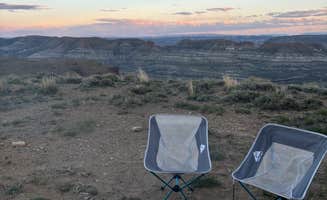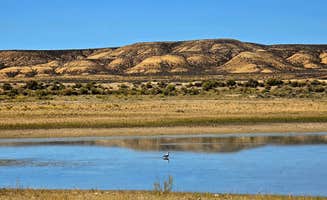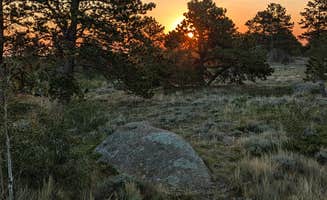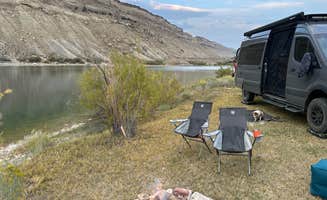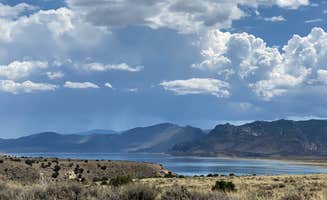Primitive camping near Rock Springs, Wyoming offers extensive options on public lands across elevations ranging from 6,200 to 7,800 feet. The region experiences temperature swings of up to 40°F between day and night, even in summer months. Most dispersed sites sit on high desert terrain characterized by sagebrush, rocky outcrops, and limited natural shade.
What to do
Paddle the reservoir: Several areas around Flaming Gorge provide direct water access for kayaking and paddleboarding. "We could ride the ATVs from campsite and had hundreds of miles of trails to choose from. Saw wild horses," noted one visitor to White Mountain Road.
Watch for wildlife: The area hosts diverse wildlife beyond the reservoir. "Antelope, deer and birds of all kinds are plentiful" at Buckboard Cove Dispersed Campsite, where campers often spot animals from their sites.
Rockhound for treasures: The desert landscape contains geological finds. "The walk along the water was beautiful and we had found some incredible rocks," reports one camper at Big Sandy Reservoir. Petrified wood fragments and agate can be found in scattered locations.
Enjoy dark skies: With minimal light pollution, astronomical viewing is exceptional. "The silence was deafening. And the dark skies were mesmerizing," according to a camper at Flaming Gorge NRA Dispersed.
What campers like
Level spots on the Wyoming side: The less developed Wyoming portion offers more secluded camping. "There are a TON of dispersed camping spots here. It's like a labyrinth of roads and spots," explains a visitor to Spring Creek Road Dispersed, noting "the dirt road was in good condition and easy to drive on."
Reliable cell service: Surprisingly strong connectivity exists in many locations. "Getting over 400mbs on T-Mobile 5g," reports one camper at Middle Baxter Road, while another mentions "full bars of LTE extended network on Verizon" at Spring Creek Road.
Seasonal temperature variations: Higher elevation sites provide cooler conditions during hot months. "A little bit more breezy and cool than down below. Lots of great places to pull over," notes a camper at White Mountain Road, describing the elevation advantage.
Established fire rings: Most popular dispersed sites contain existing stone fire rings. "The view is incredible and they have nice firepits," explains a White Mountain Road visitor, although fire restrictions frequently apply during summer.
What you should know
Wind conditions: Wind can be substantial at higher elevations. "As reviews said, it's definitely windy. But it was not miserable in my opinion, just took a little adjusting," notes one camper at White Mountain Road. Wind often subsides at night but can complicate tent setup.
Road conditions after rain: Access roads deteriorate quickly in wet weather. "The dirt road in isn't too bad and is pretty short, there were plenty of sedans driving in so it's accessible for most vehicles when the ground is dry," explains one Spring Creek Road camper. Four-wheel drive becomes necessary on many roads after rainfall.
Bugs near water: Insect activity concentrates around water bodies, particularly at dusk. "Lots of bugs, but overall it was still a great spot for the night," notes a visitor to Big Sandy Reservoir. Midges, which resemble mosquitoes but don't bite, gather in large numbers near Flaming Gorge.
Gate access: Some areas require opening gates to access. "We did have to open a gate and it was really hard to open," explains a Spring Creek Road visitor. Leave gates as you found them, either open or closed.
Tips for camping with families
Scout for glass: Unfortunately, broken glass appears at several popular sites. "Watch your step! There was a ton of broken glass at multiple sites. My dog even cut his nose on a piece," warns a camper at Green River Flaming Gorge Dispersed Site. Inspect sites carefully before setting up.
Bring extra water: No reliable water sources exist at dispersed sites. "It's desert like. There's no shade," explains a Flaming Gorge NRA visitor, noting the need for substantial water supplies.
Plan for temperature swings: Days can reach over 90°F while nights drop below 50°F. "Windy as others have stated and no cover," confirms a White Mountain Road camper, emphasizing the need for proper clothing layers.
Choose sites with natural barriers: Open landscapes provide little privacy between campers. "We are about 60' truck and fifthwheel. The road up coming from the east was pretty easy though bumpy," notes one visitor to White Mountain Road, explaining site selection.
Tips from RVers
Turn-around space: Many dispersed roads lack designated turning areas for larger rigs. "We are about 60' truck and fifthwheel... the main area really only has one spot for anything around 40' to be able to easily turn around without driving off the packed road," cautions a visitor to Little Mountain Dispersed Camp.
Leveling challenges: The rocky terrain often creates uneven camping surfaces. "Not level but tons of space. Several other rigs here and no one is close to each other," reports a Middle Baxter Road camper.
Scout before committing: GPS directions sometimes lead to unsuitable roads. "Be careful if you put in your GPS coming from the east! It takes you to a dirt road with a 27% grade up and over the mountain! Don't try to drive down it with a big rig!" warns a White Mountain Road visitor.
Overnight weather preparation: Night winds can become problematic for RV stabilizers and awnings. "Windy but it was not miserable in my opinion, just took a little adjusting. The views are pretty spectacular," explains another White Mountain Road camper.



